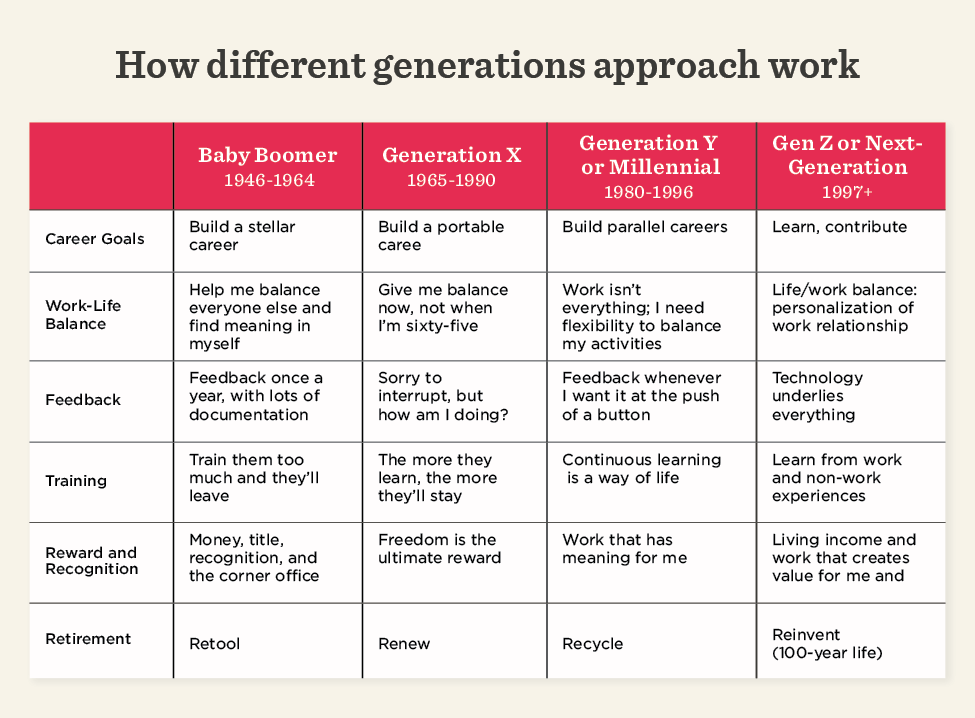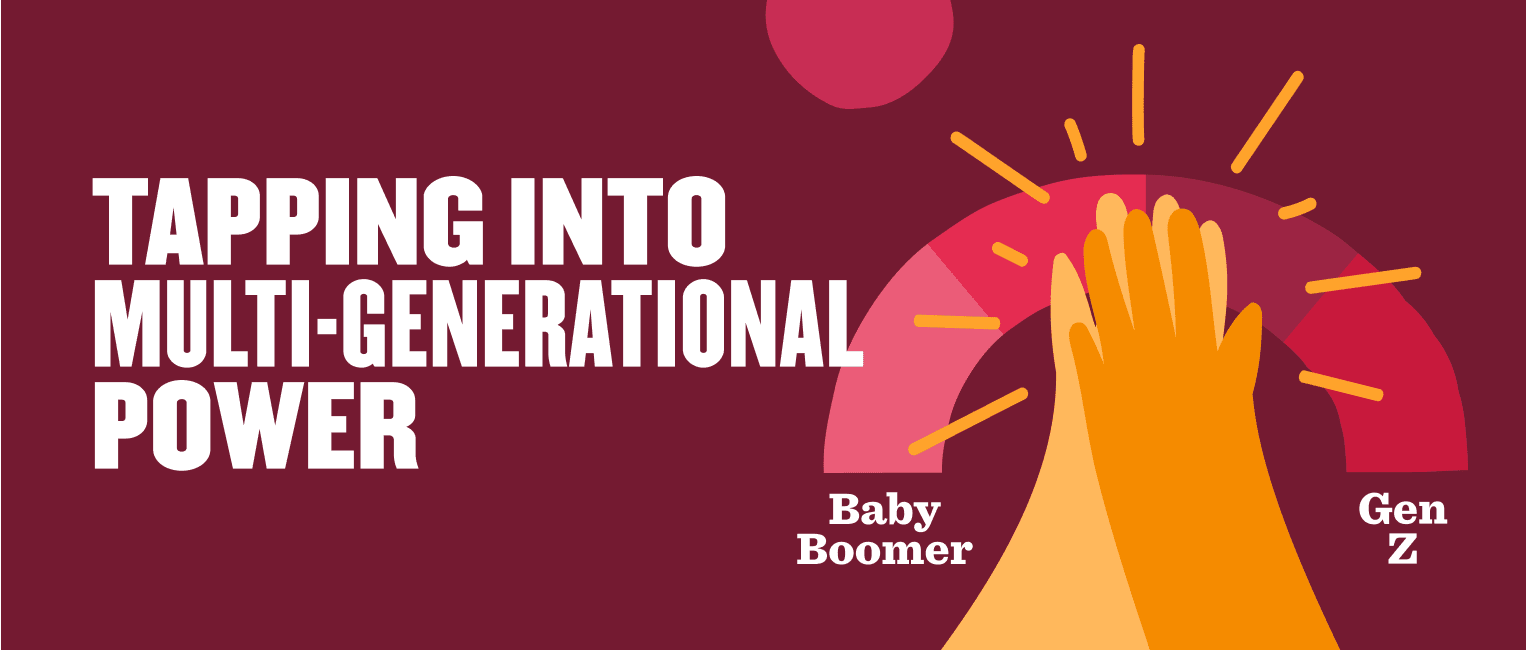Today’s workforce spans at least four generations. They equip companies with nearly a century of workforce evolution and experience when brought together. The value of this experience is priceless.
But, the reality of having Baby Boomers, Gen X, Millennials, and Gen Z working together on the same team definitely comes with challenges. If we’re being honest, that’s not surprising. Over the last eight decades, how we work, where we work, and the tools and new technologies we use to get work done and communicate have changed dramatically.
Every generation holds particular expectations and experiences that bring unique value to the workforce. Sometimes, people view these generational differences as weaknesses. The bigger challenge is overcoming conflicting values, generational and age biases, and stereotypes that often cause friction between co-workers across different age groups.
The key to strong, multi-generational teams is finding common ground
Managing diverse, multi-generational workforces and bridging the gaps to help professionals of every age work together to reach their full potential is one of the biggest challenges companies face today.
The key is finding mutual understanding and common ground between professionals across different age groups. According to Dave Ulrich in an HR Congress article, it starts with a people-centric business strategy that’s attentive to why and how people work.

When people know why their colleagues show up every day, it’s easier to understand what motivates them to get up and clock in. Maybe it’s earning money to support their family. Maybe it’s because they take pride in working for a company and with a product that aligns with their values. Perhaps it’s a combination of both (and more).
Whatever the reason, when people understand each other’s motives, it “helps [them] forge common bonds across generations” and work together more efficiently. It also helps HR and business leaders “tailor management approaches for each generation.”
Everyday practices can help bridge generational gaps in today’s workplace
What do these tailored management approaches look like in practical terms? The most successful companies capitalize on every individual’s strengths with a business strategy that incorporates knowledge sharing and collaboration into their workflows to get the best of every team member.
Here are four practices to consider building into your daily workflow to help narrow generational gaps and forge common bonds between each of your valuable team members.
1. Provide communication training
Communication is a hot topic in today’s dispersed, remote, and hybrid world of work. That’s no surprise, especially considering teams’ reliance on comms technologies like Zoom, Slack, and Microsoft Teams just to start a real-time conversation.
In our modern, multi-generational, and multi-national workforce, it’s critical that every team member feels comfortable communicating over various channels and different media, including face-to-face, text and instant messaging, email, and video comms tools. But optimal and healthy communication needs so much more than just the technology that allows people to speak with each other.
Once they’ve overcome any comms tech hurdles, a more significant challenge remains: People from different generations often feel like they’re speaking a foreign language when they try communicating with each other.
Even when we’re speaking the same language, we’re not speaking the same language
An emerging challenge for companies is how to ensure people communicate clearly and effectively once they’re in the same room, whether it’s physical or virtual. This challenge is rooted, in large part, in the fact that each generation grew up using different modes of communication.
Gen X and Baby Boomers grew up in eras before email, text, and digital comms were mainstream. Conversely, many Gen Zers and Millennials can hold entire conversations using just emojis and may not remember a time before smartphones. Because of this, members of each generation may feel lost when speaking (or writing) to their peers.
People of different ages often use different speech patterns, idioms, and cultural references. What’s meant as a compliment by a member of one generation may come off as an insult to another.
It’s important to help team members of all ages understand each other, get comfortable communicating over different media types, and become acquainted with the nuances of language and speech they each use. One way to overcome this challenge may be to hold training courses on multi-generational communication.
On the other hand, providing your people with a personal view of each other’s experiences and ways of thinking can be even more valuable than any course (and more cost-effective to boot!).
2. Pass on institutional knowledge
There’s no substitute for experience, and learning from someone who’s already “been there, done that” is invaluable.
Incorporating institutional knowledge sharing into your business strategy can answer many of today’s challenges. For instance, many workforce newcomers feel unprepared or out of their depth due to remote and hybrid work, with no one to mentor them or show them the ropes.
One way to encourage knowledge-sharing is to assign a combination of young professionals and industry veterans to every project. This will help workforce newcomers get more acquainted with the industry. It’s also a great way to help your multi-generational team members get to know each other and understand their values, challenges, and ways of thinking.
3. Encourage reverse mentoring
Knowledge-sharing workshops and the buddy system can also be a strategic way to encourage reverse mentoring on your teams. Veterans may have the industry experience junior team members lack, but entry-level professionals have a different set of equally valuable skills and experiences they can pass on.
Younger generations grew up with more modern tech and may be more tech-savvy than their veteran counterparts. But helping older team members adjust to the latest software or gadgets is just part of the picture. Reverse mentoring can also expose workforce veterans to new cultural trends and modes of thinking, helping them better understand their target market, and enriching their output.
Recommended For Further Reading
4. Invest in traditional professional development
Peer mentorship and knowledge-sharing are incredible ways to upskill (and sometimes reskill) your people. But sometimes, good old traditional L&D is the way to go.
To keep up with the ever-increasing technological advances, shifting modes of work, and evolving industries, companies prioritizing professional development have an easier time attracting and retaining top talent.
Investing in traditional training courses can benefit professionals of any age. In fact, research by Gallup shows that 61 percent of today’s professionals consider career upskilling opportunities one of the most important reasons to stick with their current position. In addition, 71 percent report higher job satisfaction when given learning opportunities at work.
Multi-generational experience and knowledge-sharing strengthen your workforce
The best success rates come from working together, powering through differences, and leveraging the diversity of thought, background, and experience every individual brings to the table.
The combined experiences and skill sets of today’s professionals provide companies with a wealth of knowledge, viewpoints, and expertise spanning nearly a century. Companies that encourage cross-generational communication, knowledge-sharing, and collaboration equip their people and the business with the tools and skills to overcome stereotypes, ageism, and resistance to change–ultimately boosting innovation and the bottom line.


